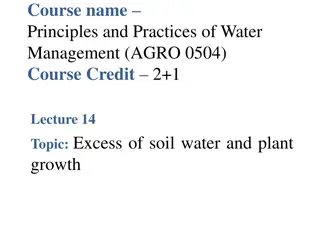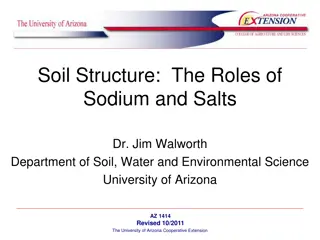Understanding Water Management: Principles, Practices, and Soil-Water Relations
Explore the principles and practices of water management in agriculture with a focus on water availability, nutrient relationships, and losses. Discover the physical classification of water, available water defined between field capacity and wilting point, soil water potential, and the soil-plant-atmosphere continuum. Learn about the gravitational and capillary water classification and their significance in soil moisture tension. Enhance your understanding of the movement of water through the soil-plant-atmosphere continuum.
Download Presentation

Please find below an Image/Link to download the presentation.
The content on the website is provided AS IS for your information and personal use only. It may not be sold, licensed, or shared on other websites without obtaining consent from the author. Download presentation by click this link. If you encounter any issues during the download, it is possible that the publisher has removed the file from their server.
E N D
Presentation Transcript
Course name Principles and Practices of Water Management (AGRO 0504) Course Credit 2+1 Lecture 8 Topic: Water availability and its relationship with nutrient availability and loses
Available water (AW) is defined as the soil moisture between field capacity (FC) and the permanent wilting point (PWP): AW = FC - PWP Water between FC and saturation is not considered available because it is lost through drainage. Water at tensions greater than PWP is held too tightly by the soil for plants to remove.
Soil Water Potential The SWP potential is defined as the potential energy of water in soil. The SWP is quantified relative to a standard state where water has no solutes, free from external forces except gravity, at a reference pressure, at a reference temperature and at a reference elevation . The SWP is then defined as the energy state of water in soil with respect to the energy of water at the reference state. The total SWP ( t ) is determined by a variety of forces acting on the soil water, including gravitational ( g ), matric (capillary and adsorptive, m ), osmotic ( o ) and hydrostatic ( h ). t = g + m + o + h
Soil-Plant-Atmosphere Continuum The movement of water from the soil, into the roots, through the xylem and from the leaf into the atmosphere, occurs because of a series of water potential gradients. The system that involves the soil, the plant s roots, the xylem, the leaf and the atmosphere, is called the soil-plant-atmosphere continuum (SPAC)
Physical Classification of Water 1.Gravitational water Water held between 0.0 to 0.33 bars (0 to 33 kPa) soil moisture tension, free and in excess of field capacity, which moves rapidly down towards the water table under the influence of gravity is termed as gravitational water 2. Capillary water As the name suggests capillary water is held in the pores of capillary size i.e., micro pores around the soil particles by adhesion (attraction of water molecules for soil particles), cohesion (attraction between water molecules) and surface tension phenomena.It includes available form of liquid water extracted by growing plants and is held between field capacity (0.33 bars or 33 kPa) and hygroscopic coefficient (31 bars or 3100 kPa)
However, the water within the capillary range is not equally available i.e., it is readily available starting from 0.33 bars up to a certain point often referred to as critical soil moisture level (for most crops it varies between 20 to 50% depletion of available soil moisture) and thereafter up to 15 bars ( 1500 kPa) it is slowly available. Further below, when the soil exerts tensions between 15 bars and 31 bars, the water is held very tightly in thin films and is practically not available for plant use. The capillary water moves in any direction but always in the direction of increasing tension and decreasing potential. 3.Hygroscopic water The water held tightly in thin films of 4 5 milli microns thickness on the surface of soil colloidal particles at 31 bars tension ( 3100 kPa) and above is termed as hygroscopic water (Fig. 8.1). It is essentially non-liquid and moves primarily in vapour form. Plants cannot absorb such water because, it is held very tenaciously by the soil particles (i.e., > 31 bars). However, some microorganisms may utilize it. Unlike capillary water which evaporates easily at atmospheric temperatures (i.e., it requires very little energy for its removal), hygroscopic water cannot be separated from the soil unless it is heated at 100 C and above for 24 hours.
LEVELS OF SOIL MOISTURE Saturation: Almost all of the pores filled with water with no air. Generally happens right after heavy rainfall / snow melt or application of flood irrigation. Field Capacity: Excessive moisture drained with gravitational force, mostly out of macro-pores. Medium and small pores will still be filled with water held due to adhesion and cohesion. Depending on the soil type, happens between 1 to 3 days after a heavy rainfall.
LEVELS OF SOIL MOISTURE Permanent Wilting Point: Not enough available moisture for normal plant growth. Continuous unavailability causes plant wilting and ultimately death. Hygroscopic Moisture Level: Soil is air dry with no availability of moisture for plants.
PLANT AVAILABLE WATER Water holding capacity: Amount of soil water held between field capacity and permanent wilting point. Plant available water: Portion of water holding capacity that can be absorbed by the plants. As a general rule, plant available water is considered to be 50 percent of the water holding capacity.
TYPES OF SOIL WATER Gravitational Water: Free water Macro-pores Moves rapidly under good soil drainage conditions Is not available to plants Under poor soil drainage conditions, cause plant wilting due to lack of soil oxygen Courtesy of F. Casey
GRAVITATIONAL WATER Under good soil drainage: Leaches excessive salts Oxygen Under poor soil drainage: High groundwater levels Lack of soil oxygen Buildup of excessive salts How do you improve conditions? Build aggregates Rooting channels Reduce compaction Use water with crops Subsurface and Surface drainage
TYPES OF SOIL WATER Capillary Water: Plant available water Tension Adhesion (attraction to soil) Cohesion (attraction to water) Evaporation Courtesy of F. Casey
CAPILLARY RISE Can move to any direction from wet areas (low soil moisture tension) to dry area (high soil moisture tension).
CAPILLARY RISE Under good soil drainage: Movement remains restricted below the rooting zone of most of the crops, due to low groundwater levels No buildup of excessive salts Under poor soil drainage: Excessive buildup of salts Poor growth environment























